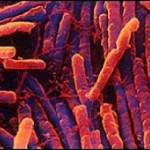infection
Photo of sea sponges by Steve Rupp, National Science Foundation via Wikimedia Commons
Through the course of evolution vertebrates have apparently lost their gene-encoded viral defense mechanisms. These ancient defenses allow plants and insects to silence the expression of certain genes by using what is known as RNA interference. This natural defense system can be manipulated to create genetically modified crops that resist certain infections. However, a new study by researchers from the University of Leuven in Belgium examined over 40 organisms in search of a specific family of proteins…
Image of a Komodo dragon By Charlesjsharp - Own work, from Sharp Photography, sharpphotography, CC BY-SA 4.0, via Wikimedia Commons
Researchers at George Mason University have created a synthetic version of a peptide found in the blood of Komodo dragons (Varanus komodoensis). They dubbed the synthetic peptide DRGN-1. Living up to its name, DRGN-1 proved to be pretty tough against microbes (Pseudomonas aeruginosa and Staphylococcus aureus) as well as biofilms. Bacteria stick together to create biofilms that attach to surfaces and help to protect…
The blue blood of horseshoe crabs contains a special chemical limulus amebocyte lysate (LAL) that medical laboratories obtain from thousands of animals annually to detect bacterial infections in humans. The labs are only allowed to draw up to 30% of their blood once a year. Despite these precautions, researchers are becoming increasingly concerned that some animals may be injured during the process resulting in the death of animals after they are returned to the ocean. In fact, some researchers are pushing to add horseshoe crabs to the vulnerable list as populations decline in some countries…
Left to right, Granny Beck, my Grandma June, and Great-Great Grandma Bertha, circa 1961. Who knows what was on the menu that day.
My Great-Grandpa and Granny Beck were, in some ways, ahead of their time. My Grandpa’s mom and step-dad, they both went through scandalous divorces and then switched partners with another couple, Granny Orpha marrying Wade and my Grandpa’s dad Lee marrying Wade’s ex-wife, Edna. Orpha and Wade raised 5 of Orpha’s boys together, and had a daughter after the divorce/remarriage.
By the time I was born, my Granny Beck was in her 80s, and I have only vague…
Image of C. difficile from BBC News.
You may recall a prior post about a dog that could smell when patients were infected with Clostridium difficile. C. difficile causes about 14,000 deaths per year in the United States. Recent breakthroughs in understanding gut microbes have led to the successful treatment of C. difficile in patients. Fecal transplants, the transfer of feces from a healthy person, has been life-saving for some patients for whom medical treatments are not effective or for recurrent infections. Listen to Billie's story here. To date, feces have been…
Image of Indian Flying Fox from Wikipedia, Fritz Geller-Grimm
An ambititous project seeks to identify all unknown viruses in mammals to determine the relative risk of infection to humans and to develop strategies to prevent and treat infections before they become pandemics. The pioneering research team is led by Dr. Simon Anthony at Columbia University and Dr. Peter Daszak from EcoHealth Alliance.
The team started by looking for viral infections in the Indian flying fox (Pteropus giganteus), a species with pathogens known to transfer to humans (Nipah and Hendra viruses). Over five…
There are a lot of reasons that posts to this blog sometimes don't happen for months at a time, but one of them is that I can often get sucked down the rabbit hole that is Reddit. If you don't know about reddit yet, you may not want to click that link, but if you do know (and you're reading this blog), you may know about one of the communities (subreddits) there - a place called r/askscience. It's a forum where people can ask questions of a scientific nature (anything from "Why are pigeons so successful as an urban animal?" to "What's so special about the speed of light?"), and then actual…
A study published in the European Journal of Personality suggests that humans infected with toxoplasmosis gondii are more extroverted compared to non-infected individuals. According to the CDC, roughly 22.5% of Americans over 12 are infected. The effects of the parasite are attributed to increased levels of dopamine in the brains of infected individuals. People can become infected with the parasite through exposure to undercooked contaminated meat, unwashed fruits and vegetables from contaminated soil as well as infected cat litter.
Source:
Lindová J, Příplatová L, Flegr J. Higher…
The BBC reports that for the first time, scientists have been able to watch the an infection develop in real time, inside an animal. The best part? They used a special glowing bacteria and measured the rays of light escaping from the animal's body:
The researchers used a genetically modified version of a mouse bug, Citrobacter rodentium, which produces light.
Dr James Collins, who works in Prof Frankel's lab, then puts the infected mice inside the scanner.
"It is a dark box which keeps the animals warm and blocks any other light from coming in. It has a camera at the top so we can very…
Over at White Coat Underground, Pal has the post that I've been meaning to write. Earlier this summer, a family member posted on Facebook that a friend of her daughter was nursing a "nasty spider bite" that she got while camping in Michigan. Her post claimed it was a Brown Recluse bite. Being my usually buttinski self, I posted and told her that it was really, really unlikely to be a brown recluse bite, and that the friend-of-the-daughter-of-the-relative should hie thee to her physician and get the "bite" checked out. I told her that rather than a spider bite, it could be a Staph infection…
Maryn McKenna has a great update today on the E. coli situation, looking at where we are as far as unanswered questions about the outbreak and the strain. It's been a messy day; more evidence seems to point to the sprout farm, but CIDRAP also notes that another contaminated cucumber was found in the compost bin of a family sickened by the bacterium (this one had the correct serotype--O104), but it's impossible to tell at this point whether the cucumber was the source of that bacterium or it ended up there from one of the sickened family members. Twists and turns abound in this investigation…
ALZHEIMER'S Disease is the most common form of dementia, affecting an estimated 30 million people worldwide. The cause of the condition is unknown, but the prime suspect is amyloid-beta (Aβ), a 42-amino acid peptide which accumulates within neurons to form insoluble structures called senile plaques that are thought to be toxic. Aβ is synthesized in all neurons; it is associated with the cell membrane, and is thought to be involved in cell-to-cell signalling, but its exact role has eluded researchers.
A new study published in the open access journal PLoS One now shows that Aβ is a potent…
Student guest post by Anne Dressler
The idea of evolutionary medicine is new to me and my understanding is quite shallow but it has piqued my interest. Currently, the book "Why We Get Sick" by Randolph M. Nesse and George C. Williams has been satisfying my curiosity during the 15 minutes of intellectual thought I have left at the end of the day while reading before bed. From what I've read, I'm finding how useful it can be to consider disease in light of evolution and I'm left wondering how I haven't heard of it before. I'm guessing I'm not the only one interested, so let's talk evolutionary…
It's amazing what the kids are up to these days.
This one comes live from Mount Sinai (my present educational residence). Hubner et al., publishing in Science, use an infectious, fluorescent strain of HIV to watch the virus move from one cell to another. Their results are fascinating and may help us develop better ways to treat the disease.
(Full disclaimer: This research was performed in the Chen lab at Mount Sinai where my roommate presently works.)
It's funny how my biases work. I mean, I am not a microbiologist, but here is the bias that I had about how infections like HIV work: I…



